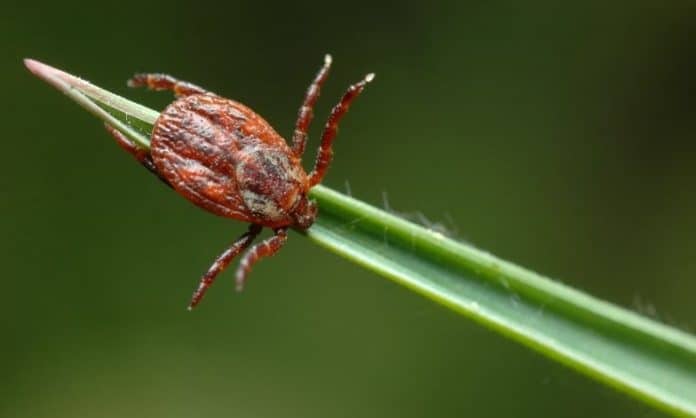The arrival of spring and rising temperatures means the return and multiplication of ticks. The month of May is dedicated to raising awareness of Lyme disease and helping to educate the public about the symptoms and cause of this disease.
In Europe, it is considered the most widespread vector-borne disease* in the region and more than 360,000 cases have been reported over the past two decades. In France, the Pasteur Institute reported an estimated annual incidence rate (number of new cases) of approximately 53 per 100,000 people between 2009 and 2017.
On this occasion, UNRIC interviewed Dr. Océane Sorel, a specialist in virology, immunology and member of the United Nations “Team Halo”**, about this disease. You can also find her on Instagram, @thefrenchvirologist where she popularizes medical science with humour.
What is Lyme disease?
It is an infectious disease caused by a bacterium called Borrelia burgdorferi. It is transmitted by a tick bite infected with the bacteria.
When an infected tick bites you, the bacteria passes into your body through its saliva, then multiplies and spreads.*
It takes some time for the bacteria to be transmitted, which is why the risk of infection is usually low when the tick is on your body for less than 24 hours.
This disease is transmitted only through tick bites and cannot be transmitted from human to human.
What are the symptoms?
The most visible and recognizable symptom is a very characteristic mark on the skin: a red dot surrounded by white and then another red circle, a bit like a target. This is an erythema migrans, which appears around the tick bite.
There may also be flu-like symptoms such as fever, chills, headache or body aches.
If the disease is not treated quickly within a few weeks after the spread of the bacteria, other symptoms may appear, such as nervous, joint or skin disorders, which may eventually have consequences.
When and how to get diagnosed?
Without symptoms, there is no need to be tested for Lyme disease.
However, if a Erythema migrans is present, the diagnosis can be made with certainty.
In addition to the symptoms mentioned above, there are other factors to consider:
- The geographical area where the bite took place;
- Symptoms that are suggestive for Lyme disease;
- Epidemiological elements (is the bite recent? Is the bacteria present in the geographical area?)
- As well as blood tests, ELISA and Western blot, both tests must be positive.
What is the treatment for Lyme disease?
Most people recover from the disease, without any after-effects, by taking antibiotics to eliminate the bacteria. This treatment should be started as soon as possible after the diagnosis.
In rarer cases, if the disease is not treated in time, some symptoms may persist, such as fatigue, nerve problems or joint pain. These symptoms are called “post-Lyme syndrome” but the causes are still unclear and are the subject of controversy in the scientific and medical world.
Is there already a vaccine available?
Unfortunately, there is no vaccine available on the market yet, although some vaccines are currently being developed.
How to protect yourself ?
To avoid tick bites, you should be careful in high-risk areas such as forests or tall grass, wear long clothes and make a habit of checking your body thoroughly after a walk in nature.
Some tick repellents are also effective.
Do climate change and changes in biodiversity have an impact on the development of the bacteria or on its transmission?
Lyme disease mainly affects the temperate regions of the northern hemisphere. Some geographical areas are more affected than others.
Future climate changes are likely to increase the spread of Lyme disease, as they significantly affect ecosystems.
To counter this threat, preventive measures such as public information, surveillance activities and standardized data collection methods need to be strengthened.
In 2016, WHO launched a new strategic approach called Global Action for Vector Control 2017-2030 which aims to control these diseases while minimizing the impact on the environment.
*Vector-borne diseases are diseases caused by parasites, viruses or bacteria transmitted by vectors. Vectors are living organisms capable of transmitting infectious diseases from one host (animal or human) to another.
**The Halo Team was created as part of the United Nations Verified initiative and brings together scientists and health professionals from all over the world who are working to combat scientific misinformation.
To learn more about Dr. Sorel’s expertise:
- COVID-19, enfants et vaccins : les réponses à vos questions (unric.org)
- Papillomavirus : un vaccin pour tous les jeunes ? (unric.org)
Sources
- Maladie de Lyme (Borréliose de Lyme). Institut Pasteur
- Recommandations de bonnes pratiques. Hautes Autorités de Santé
- Recent Progress in Lyme Disease and Remaining Challenges. NLM
- Comparison of Lyme Disease in the United States and Europe. NLM
- Lyme Disease Frontiers: Reconciling Borrelia Biology and Clinical Conundrums. NLM
- Maladie de Lyme. Vidal
- Borréliose de Lyme. Santé publique France
- Recent Progress in Lyme Disease and Remaining Challenges. Frontiers in medicine

